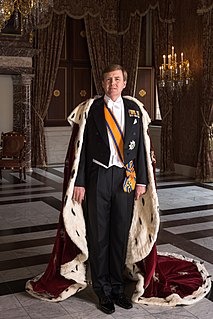
Willem-Alexander is the King of the Netherlands, having acceded to the throne following his mother's abdication in 2013.

Máxima is the queen of the Netherlands as the spouse of King Willem-Alexander. Argentine by birth, she worked in marketing when she met Willem-Alexander, eldest son and heir apparent of Queen Beatrix, in 1999. They married in 2002, and became king and queen on the abdication of her mother-in-law on in 2013. As princess and as queen, Máxima has promoted social integration of immigrants, LGBT rights, and financial inclusion. She and Willem-Alexander have three daughters, Princesses Catharina-Amalia, Alexia, and Ariane, who are first, second, and third, respectively, in the line of succession.
To be mentioned in dispatches describes a member of the armed forces whose name appears in an official report written by a superior officer and sent to the high command, in which their gallant or meritorious action in the face of the enemy is described.
The Order of the Crown is a national order of the Kingdom of Belgium. The Order is one of Belgium's highest honors.

The Military William Order, or often named Military Order of William, is the oldest and highest honour of the Kingdom of the Netherlands. The Order is named after St. William of Gellone (755–814), the first Prince of Orange. The Order's motto is Voor Moed, Beleid en Trouw. The chivalric order was established on 30 April 1815 by King William I and was presented for feats of excellent bravery on the battlefield and as a meritorious decoration to senior military officers. Comparable with the French Légion d’Honneur but far less often awarded, the Military William Order is a chivalry order of merit open to everyone regardless of rank and nobility, and not only to Dutch military but also foreigners. To date membership of the Order is extremely rarely awarded and only for excellent bravery in battle.

The Order of Orange-Nassau is a civil and military Dutch order of chivalry founded on 4 April 1892 by the Queen regent Emma, acting on behalf of her under-age daughter Queen Wilhelmina.
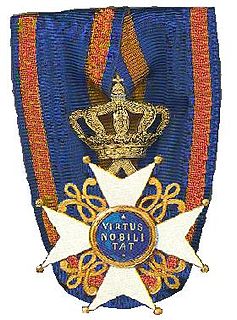
The Order of the Netherlands Lion, also known as the Order of the Lion of the Netherlands is a Dutch order of chivalry founded by King William I of the Netherlands on 29 September 1815.

The Order of the House of Orange, sometimes referred to as the House Order of Orange, is a dynastic order of the House of Orange-Nassau, the royal family of the Netherlands similar to the Royal Victorian Order in the United Kingdom. The order was instituted by Queen Wilhelmina of the Netherlands on 19 March 1905 and is not subject to ministerial responsibility or influence, but is awarded at the discretion of the Dutch monarch alone.
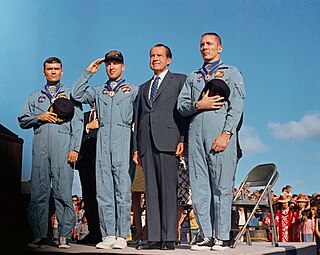
A necklet is a type of decoration which is designed to be worn and displayed around a person's neck, rather than hung (draped) from the chest as is the standard practice for displaying most decorations.
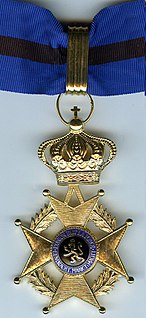
The Order of Leopold II is an order of Belgium and is named in honor of King Leopold II. The decoration was established on 24 August 1900 by Leopold II as Sovereign of the Congo Free State and was in 1908, upon Congo being handed over to Belgium, incorporated into the Belgian awards system. The order is awarded for meritorious service to the sovereign of Belgium, and as a token of his personal goodwill. It can be awarded to both Belgians and foreigners, and is seen as diplomatic gift of merit.

The flags of the Dutch royal family are a set of flags used to identify a member of the royal family. The current system of flags for the Dutch monarch, princes, and princesses was introduced in 1908.
On 20 February 1941, the Dutch government in exile in London instituted several new awards for bravery. The new way that wars were fought, with civilian resistance and the merchant navy in great peril, made this necessary. Amongst the new decorations was the "Cross of Merit", an award for "working in the interest of the Netherlands while faced with enemy actions and distinguishing oneself through valor and resolute behavior". One did not have to be on the front line to win this award.

The Order of the Gold Lion of the House of Nassau is a chivalric order shared by the two branches of the House of Nassau.
The Honorary Medal for Charitable Assistance was created at 18 June 1822 and is after the Military William Order the oldest decoration for bravery in the Kingdom of the Netherlands. Furthermore, the Honorary Medal is the highest civilian decoration still being awarded for bravery, and is specifically for those who carried out a voluntary act of bravery or self-sacrifice, with an emphasis on charity.
The Honorable Mention was an important Military awards and decorations of the Kingdom of the Netherlands for those who distinguished themselves by acts of high bravery, but weren't eligible yet for the highest accolade of the Military William Order. The Honorable Mention was in fact not a medal but a mention in the proclamation of the Dutch army, to honor the soldier.
The Decoration of Merit is an important military decoration for bravery in the Netherlands. The medal was established by the Dutch minister of defence, Wim van Eekelen, on 16 April 1987. The award was created by ministerial decree and is therefore a medal of the Netherlands Ministry of Defence and not a royal decoration.
The Croix de guerre (French) or Oorlogskruis (Dutch), both literally translating as "Cross of War", is a military decoration of the Kingdom of Belgium established by royal decree on 25 October 1915. It was primarily awarded for bravery or other military virtue on the battlefield. The award was reestablished on 20 July 1940 by the Belgian government in exile for recognition of bravery and military virtue during World War II. The post-1940 decoration could also be awarded to units that were cited. The decoration was again reestablished by royal decree on 3 April 1954 for award during future conflicts.
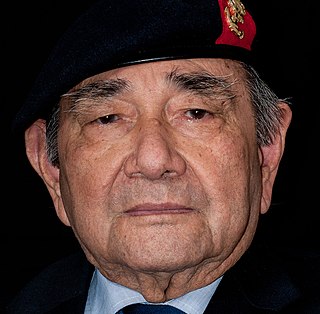
Giovanni Narcissus Hakkenberg was a Dutch marine of Indo-European descent, and decorated war hero and knight of the Military Order of William. The Military William Order is the highest honour in the Netherlands, bestowed for "performing excellent acts of Bravery, Leadership and Loyalty in battle".
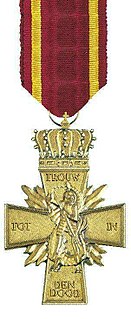
The Verzetskruis 1940–1945 is a decoration for valour in the Netherlands. Instituted on May 3, 1946, it was awarded in recognition of the individual courage shown in resistance against the enemies of the Netherlands and for the maintenance of liberties. It is one of the highest decorations in the Netherlands.












